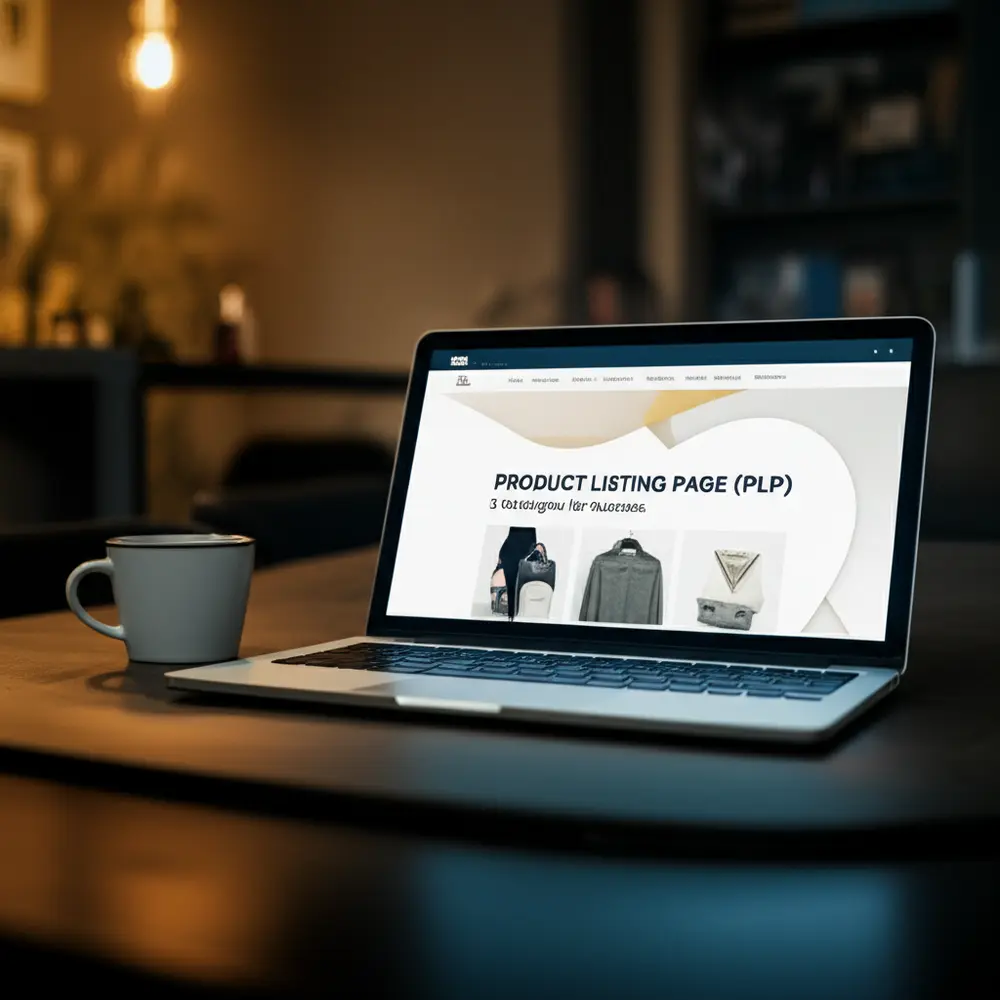Are you struggling to convert website visitors into buyers? A cluttered or slow product listing page (PLP) often frustrates potential customers. This vital interface can make or break your online sales goals.
You invest heavily in marketing, yet users abandon their carts. The problem frequently lies in how you present your products. An optimized PLP is crucial for guiding shoppers effectively through their journey.
Unlock your e-commerce potential by refining this critical touchpoint. You empower customers to find what they need, boosting satisfaction and significantly increasing your bottom line. Master your PLP now.
The Strategic Imperative of Your Product Listing Page (PLP)
Your Product Listing Page (PLP) serves as a critical interface. It acts as the direct bridge between a user’s initial search and their eventual product discovery. Far from being a mere catalog, your PLP is a foundational element for successful e-commerce.
You directly influence user experience and purchasing decisions through your PLP. A well-optimized page significantly impacts the customer journey. You guide users efficiently towards desired products, reducing friction.
Consider DecorLar & Cia., a home decor retailer struggling with high bounce rates. They revamped their PLPs by implementing structured categorization and clear filters. This led to a 25% decrease in bounce rate on their PLPs and a 15% increase in clicks to product detail pages.
Your PLP’s primary role is to facilitate informed choices. It becomes a powerful tool for Conversion Optimization. You must present products clearly, with relevant information immediately accessible, encouraging deeper exploration.
Strategic organization of product listings on your PLP is essential for a robust Retail Strategy. You empower users with categorization, intuitive filtering, and efficient sorting options. This allows them to refine their search and discover items aligning with specific needs.
PLP vs. Static Catalog: A Dynamic Conversion Battle
You face a crucial choice in presenting your products: a static catalog or a dynamic PLP. A static catalog simply lists items, offering minimal interaction. This outdated approach often leads to poor user experience and lost sales opportunities.
Conversely, a dynamic PLP actively engages your customers. You provide interactive filters, personalized sorting options, and real-time updates. This approach significantly enhances the user experience, transforming your PLP into a powerful conversion driver.
Market data reveals that e-commerce sites with dynamic filtering features report a 12% higher conversion rate. You miss out on potential revenue if you stick to a basic, non-interactive listing. Embrace dynamism to outperform competitors.
A static catalog forces users to manually sift through products, leading to frustration and abandonment. You cannot effectively meet diverse customer needs with such limitations. Your customers expect speed and relevance in their shopping journey.
With a dynamic PLP, you give customers control. They instantly narrow down options, saving time and effort. This personalized and efficient experience builds trust and encourages deeper engagement, ultimately boosting your bottom line.
Designing for Unmatched E-commerce UX
Effective E-commerce UX on your PLP demands attention to visual hierarchy. Key information like ratings, limited stock alerts, or quick-add-to-cart options must be easily scannable. You enable rapid decision-making for your shoppers.
The speed and responsiveness of your Product Listing Page (PLP) are also crucial. Slow loading times can deter users, leading to higher bounce rates and missed conversion opportunities. You ensure a seamless browsing experience across all devices through technical optimization.
PetPalace Online, a pet supply e-commerce store, saw their bounce rate drop by 18% after optimizing PLP image sizes and implementing lazy loading. This technical upgrade also increased their mobile conversion rate by 10%, directly impacting their sales targets.
A poorly designed PLP can quickly frustrate users, regardless of how compelling your products are. You understand it acts as a gatekeeper. If the user experience here falters, subsequent steps in the sales funnel become irrelevant.
You enhance user satisfaction by providing clear, high-quality product imagery. Customers trust what they can see clearly. Consistent visuals, showcasing products from multiple angles, build confidence and reduce returns, strengthening your overall retail strategy.
Visual Consistency vs. Dynamic Product Displays
You must balance visual consistency with dynamic product displays on your PLP. Visual consistency ensures a professional and trustworthy brand image. You achieve this through uniform image sizing, lighting, and background across all product cards.
Maintaining consistency reduces cognitive load for your users. They navigate your store with ease, focusing on product selection rather than adapting to varying visual presentations. This foundational element improves overall E-commerce UX.
However, you also benefit from dynamic product displays. These include personalized recommendations, “new arrival” badges, or limited-stock alerts. You can strategically highlight items, drawing immediate attention to specific products or promotions.
The challenge lies in integrating dynamic elements without disrupting visual harmony. You avoid clutter by using subtle animations or clearly delineated sections for these features. This ensures a compelling yet organized presentation.
You leverage dynamic displays to respond to real-time market trends or inventory levels. For example, dynamically featuring products with high margins or those nearing end-of-life helps you meet business objectives while maintaining an excellent user experience.
Driving Conversion Optimization Through PLP Excellence
Incorporating robust filtering and sorting tools is a cornerstone of an effective Product Listing Page (PLP). These functionalities allow users to tailor their view. You make broad product categories manageable and highly personalized, driving conversion.
From a Retail Strategy perspective, your PLP is an opportunity to showcase product breadth and depth. You reflect your brand’s merchandising approach, highlighting featured products or current promotions without overwhelming the user.
Consider TechGadget Pro, an electronics retailer. By implementing advanced faceted filtering for technical specifications, they boosted their add-to-cart rate by 22%. This precision allowed customers to find specific products, reducing search time significantly.
Continuous testing and iteration are vital for Conversion Optimization on your PLP. You conduct A/B testing on different layouts, filter options, and information display methods. This reveals optimal configurations that resonate most with your target audience.
Clear Calls to Action (CTAs) directly on your product cards streamline the path to purchase. You reduce the number of clicks required, allowing impulse buys. This accessibility improves E-commerce UX and supports a more agile retail strategy.
Automated Personalization vs. Manual Merchandising
You can optimize your PLP using either manual merchandising or automated personalization. Manual merchandising involves human curators selecting and arranging products. You maintain full control over promotional displays and brand messaging.
This approach allows for highly curated collections that align perfectly with specific marketing campaigns. However, it is resource-intensive and struggles to scale with large inventories. You might miss opportunities for individualized customer experiences.
Automated personalization, conversely, leverages AI and machine learning. You present tailored product recommendations based on individual browsing history, purchase behavior, and demographic data. This dynamic approach adapts to each user in real-time.
Automated systems can significantly boost conversion rates, often by 15-20% according to industry reports. You provide a highly relevant shopping experience without manual intervention. This frees up your team for more strategic tasks, such as implementing an Official WhatsApp Business API to enhance customer support.
The optimal solution often involves a hybrid approach. You use manual merchandising for high-impact seasonal campaigns and automated personalization for everyday browsing. This ensures both brand consistency and individualized relevance, maximizing your ROI.
Step-by-Step to Implement A/B Testing on Your PLP
You can identify winning PLP elements by systematically A/B testing. First, you define a clear hypothesis, such as “changing filter placement will increase click-through rates by 10%.” This focuses your efforts on a specific goal.
Next, you create two distinct variations of your PLP element. For instance, test filters on the left sidebar versus above the product grid. Ensure only one variable changes between the control (A) and the variation (B).
Then, you use A/B testing software to split your audience. You direct 50% of your traffic to version A and 50% to version B. This ensures a fair comparison, providing statistically significant results.
You meticulously track relevant Key Performance Indicators (KPIs), such as click-through rate to product pages, add-to-cart rate, or conversion rate. Let the test run long enough to gather sufficient data, typically several weeks.
Finally, you analyze the results. If the variation (B) significantly outperforms the control (A), you implement the winning change across your PLP. You continuously repeat this process, iteratively refining your page for optimal performance.
Leveraging Data for Continuous PLP Growth
Optimizing your Product Listing Page (PLP) is paramount for any successful e-commerce operation. Pure guesswork no longer suffices in a competitive digital landscape. Instead, data-driven decisions must guide every enhancement to your PLP, ensuring a superior E-commerce UX.
You must understand user behavior through rigorous data analysis. This approach enables e-commerce managers and UX designers to identify friction points and opportunities on the Product Listing Page. Consequently, your improvements are based on evidence, not assumptions.
ModaChic Boutique, a fashion retailer, used A/B testing to optimize their product card layouts. By testing larger images and more prominent “Quick View” buttons, they observed a 17% increase in product page visits and a 9% rise in overall sales conversions from their PLP.
A typical e-commerce site can experience a 30% bounce rate on its PLPs. You can calculate potential lost revenue by multiplying your average order value by the number of bounced users. For instance, if 10,000 users bounce monthly with an average order value of $50, you potentially lose $500,000. Optimizing your PLP directly combats this loss.
The General Data Protection Law (LGPD) in Brazil, similar to GDPR, requires you to handle user data responsibly. When you collect browsing history for personalization, ensure you obtain explicit consent and provide transparent privacy policies. You build trust and maintain legal compliance.
Quantitative Analytics vs. Qualitative User Feedback
You need to combine both quantitative analytics and qualitative user feedback for a holistic view of your PLP performance. Quantitative data, like bounce rates or conversion rates, tells you *what* is happening on your page. You see the numbers, but not the *why*.
Qualitative feedback, however, explains *why* users behave a certain way. Through surveys, user interviews, or usability tests, you gather insights into their motivations, frustrations, and desires. This understanding is invaluable for targeted improvements.
For example, analytics might show a high exit rate on a specific category PLP. Qualitative feedback might reveal that customers cannot find a crucial filter. You use quantitative data to pinpoint the problem and qualitative data to diagnose its root cause.
You effectively refine your retail strategy by merging these two data types. Quantitative metrics provide a measurable benchmark for success, while qualitative insights offer actionable guidance for design and feature development. Both are indispensable for true optimization.
Integrating tools like a Multi-User WhatsApp setup can provide invaluable direct customer feedback. Your support team can field inquiries about specific product listings in real-time. This uncovers pain points users might encounter directly on the PLP, offering immediate, actionable insights.
Key Performance Indicators for PLPs
You use several key metrics to reveal the effectiveness of your PLP. Critically, monitoring the bounce rate and exit rate provides insight into immediate disengagement. A high bounce rate suggests users are not finding relevant products, or your page is poorly structured.
Furthermore, analyzing scroll depth indicates how deeply users engage with your content. Low scroll depth might signal a need to reconsider product arrangement or the prominence of filters. These metrics are crucial for initial page assessment and iterative improvements.
Conversion Rate and Add-to-Cart Rate are ultimate indicators of your PLP’s success. These metrics directly reflect the page’s ability to move users closer to purchase. You track their fluctuation after changes, essential for effective Conversion Optimization efforts.
Moreover, Time on Page and Click-Through Rate (CTR) to product detail pages reveal user interest and navigation efficiency. A well-performing PLP encourages deeper exploration, leading to more informed purchasing decisions by your user. You optimize for these.
You also track the usage of your filtering and sorting options. This data tells you which attributes are most important to your customers. You can then prioritize those filters or adjust your product merchandising to align with customer preferences, refining your retail strategy.
Your Roadmap to a High-Performing PLP
Mastering your Product Listing Page (PLP) is fundamental for sustainable e-commerce growth. A well-optimized PLP transforms browsing into conversions, directly impacting your bottom line. This crucial element of the E-commerce UX bridges product discovery and purchase intent.
Effective navigation is paramount for any Product Listing Page (PLP). Intuitive filters allow users to quickly narrow down vast catalogs, significantly improving the user journey. This precision is vital for a positive E-commerce UX, preventing abandonment and frustration.
High-quality product imagery is indispensable on the Product Listing Page (PLP). Clear, concise visuals, often with quick-view functionalities, capture immediate attention. Customers should grasp product essence at a glance, fostering engagement and reducing bounce rates.
The technical performance of a Product Listing Page (PLP) cannot be overstated. Rapid page load times are critical for retaining user interest and ensuring a smooth E-commerce UX. Slow PLPs directly correlate with higher bounce rates and decreased Conversion Optimization.
Given prevailing browsing habits, a mobile-first approach for your Product Listing Page (PLP) is essential. Responsive design ensures a seamless and touch-friendly experience across all devices. You capture mobile conversions effectively with this strategy.
Strategic integration of conversion-focused elements significantly elevates a Product Listing Page (PLP). Clear calls-to-action (CTAs) like “Add to Cart” or “Quick View” should be prominent yet unobtrusive, guiding users toward their next step effortlessly. You drive sales through thoughtful design.






